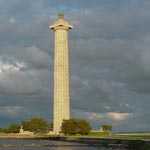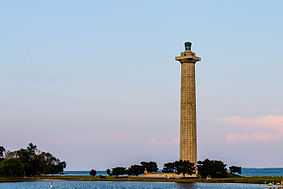Perry's Victory and International Peace Memorial
| Perry's Victory and International Peace Memorial | |||||||||
|---|---|---|---|---|---|---|---|---|---|
|
IUCN category V (protected landscape/seascape) | |||||||||
 | |||||||||
 | |||||||||
| Location | Put-in-Bay, Ohio, U.S. | ||||||||
| Nearest city | Sandusky, Ohio | ||||||||
| Coordinates | 41°39′15″N 82°48′41″W / 41.65417°N 82.81139°WCoordinates: 41°39′15″N 82°48′41″W / 41.65417°N 82.81139°W | ||||||||
| Area |
25.38 acres (10.27 ha) 24.97 acres (10.11 ha) federal | ||||||||
| Established | June 2, 1936 | ||||||||
| Visitors | 155,689 (in 2005) | ||||||||
| Governing body | National Park Service | ||||||||
| |||||||||
Perry's Victory and International Peace Memorial commemorates the Battle of Lake Erie that took place near Ohio's South Bass Island, in which Commodore Oliver Hazard Perry led a fleet to victory in one of the most significant naval battles to occur in the War of 1812.[1] Located on an isthmus on the island,[2] the memorial also celebrates the lasting peace between Britain, Canada, and the United States that followed the war.
Overview

A 352-foot (107 m) monument — the world's most massive Doric column — was constructed in Put-in-Bay, Ohio by a multi-state commission from 1912 to 1915 "to inculcate the lessons of international peace by arbitration and disarmament." Beneath the stone floor of the monument lie the remains of three American officers and three British officers.
It is among the tallest monuments in the United States (the Gateway Arch, San Jacinto Monument, and the Washington Monument are taller). Although substantially completed in 1915, funding problems prevented the proper completion of a fully realized memorial complex.[3] In 1919 the federal government assumed control of the monument and provided additional funding. The official dedication was celebrated on July 31, 1931. In 2002, 2.4 million dollars was spent on a new visitor center. The memorial is visited by 200,000 people each year.
Administrative history
Established as Perry's Victory and International Peace Memorial National Monument by Franklin D. Roosevelt on June 2, 1936 (Proclamation No. 2182); redesignated a National Memorial and renamed on October 26, 1972. As with all historic areas administered by the National Park Service, the memorial was listed on the National Register of Historic Places on October 15, 1966.
2013 US quarter coin

The 2013 "Perry's Victory and International Peace Memorial Quarter" shows Oliver Hazard Perry in the reverse design, depicting the site's statue of Perry with the International Peace Memorial in the distance.[4]
Structural concerns

The Memorial had been closed for most of the summer of 2006 after a 500 pound (230 kg) piece of granite broke off the southeast face of the observation deck, falling 315 feet (96 m) and leaving a crater in the plaza in June. No one was injured. Following a structural assessment that deemed it safe for visitors, the memorial reopened on August 26, 2006, with a fence surrounding it.
The monument closed on September 30, 2009 for repairs, and reopened on July 3, 2012.[5][6]
Other Navy memorials

References
- ↑ "Ohio History Central". Retrieved 2011-04-22.
- ↑ Williams, Sherda K.; Boyle, Susan (1994). Cultural landscape report: Perry's Victory and International Peace Memorial, Put-in-Bay, Ohio. National Park Service - Midwest Regional Office. p. 15.
- ↑ Interstate Board of the Perry's Victory Centennial Commissioners; Watterson, Henry, 1840–1921. The Perry memorial and centennial celebration under the auspices of the national government and the states of Ohio, Pennsylvania, Michigan, Illinois, Wisconsin, New York, Rhode Island, Kentucky, Minnesota and Indiana (1912) (Cleveland, Ohio: The Board)
- ↑ United States Mint. "Perry's Victory and International Peace Memorial". United States Mint. Retrieved 8 June 2013.
- ↑ "Memorial at Perry's Victory to Open July 3 After 2 Years of Restoration" (press release, 2012-06-26). Perry's Victory and International Peace Memorial website, National Park Service. Retrieved 2012-07-06.
- ↑ Jackson, Tom (2012-07-02). "Perry Memorial to Reopen Ahead of Schedule". Sandusky Register. Retrieved 2012-07-06.
- The National Parks: Index 2001–2003. Washington: U.S. Department of the Interior.
- Toledo Blade: "Perry memorial to reopen"
- Toledo Blade: "Monument shut after granite falls"
- Toldeo Blade: "Monument remains shut pending study"
- Toledo Blade: "Time chips away at Perry memorial"
Further reading
- Downloadable resources regarding Oliver Hazard Perry, including orations at the opening of the Put-in-Bay monument, American Library Association.
External links
| Wikimedia Commons has media related to Perry's Victory and International Peace Memorial. |
- National Park Service: Perry's Victory and International Peace Memorial
- Perry's Victory and International Peace Memorial Passport Stamp
- 3D model
| ||||||||||||||||||||||||||||||||||||||||||||||||||||||||||||||||||||
| ||||||||||||||||||||||||||